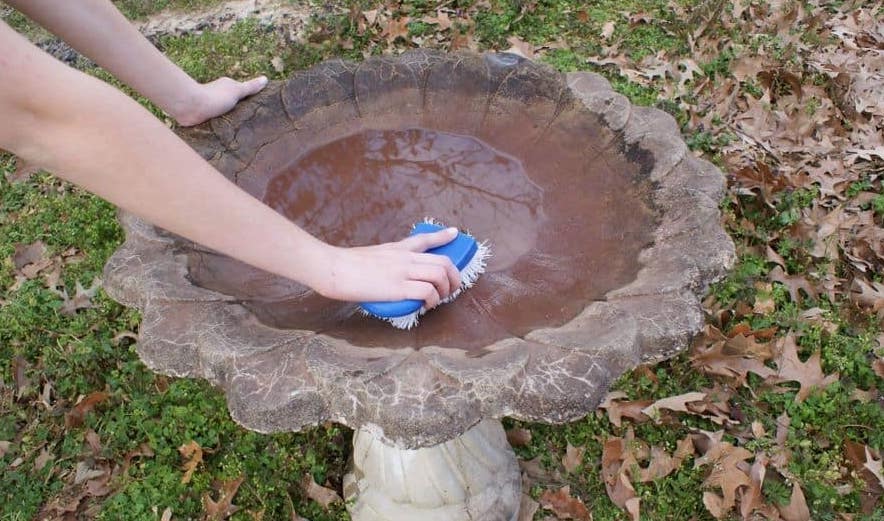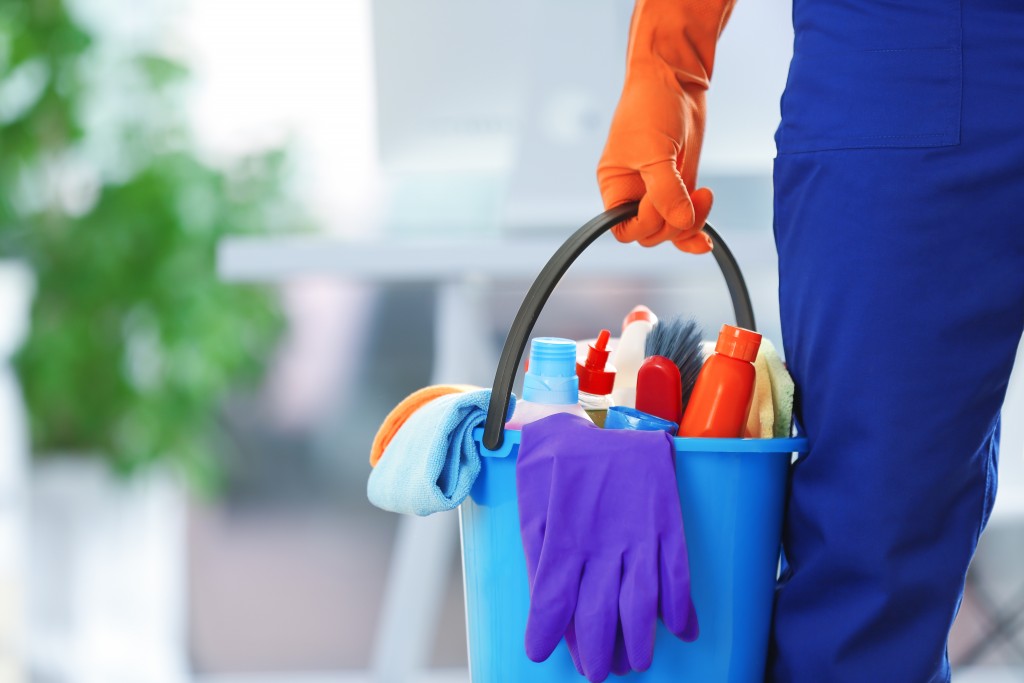

We’re here to help! Wild Yards is a completely free website that is 100% dedicated to helping you create a wildlife-friendly, sustainable yard. Read more
WildYards is reader-supported. When you buy a product through a link on our site, we may earn a comission. Every product is independently selected by our (obsessive) editors and our reviews are unbiased and objective. Read more about our mission or our privacy policy.
Keeping a clean and fresh bird bath is essential to attracting birds to your backyards.
Unfortunately, bird bath maintenance includes a little more than just topping the water in the bowl every few days. But don’t worry, in this article you’ll learn how to clean a bird bath properly and keep it fresh and healthy for your feathered friends all year long.
Is cleaning a bird bath really necessary?
Some people will claim that cleaning a bird bath isn’t necessary because puddles, rivers, or lakes aren’t cleaned regularly.
While this argument may seem compelling, it’s wrong. In fact, many birds do catch diseases or get sick from drinking or bathing in contaminated rivers and puddles. The whole point of buying a bird bath is to provide a safe and clean source of water for birds.
But, cleaning a bird bath regularly isn’t just for the benefit of the birds. It’s for us humans too. Stagnant water is the perfect breeding ground for mosquitoes and other water-borne pests. Nobody likes being eaten alive by mosquitos while trying to enjoy their backyard.
A dirty bird bath will smell, grow algae, and attract unwanted pests and overall it’s something you want to avoid.
How often do you need to clean a bird bath?
The general rule of thumb is to clean a birdbath 2-3 times a week. That seems like a lot, but often you can get away with just rinsing out the bowl with a hose and then giving it a deep scrubbing once every week or two.
How often you need to clean a bird bath depends on many different factors. Things like the weather, the number of birds using it, the material of the bird bath bowl, and it’s location will all affect how often you have to clean it. For example, in the fall you may have to go out and remove leaves and other debris from the bird bath almost daily.
If the water is starting to discolor, that’s a good sign that your bird bath needs cleaning.
Cleaning Material Required to Clean a Bird Bath
Fortunately, not much is required to give a bird bath a proper cleaning. Here’s a list of required materials and some optional ones to make your life easier:
- Water (preferably a hose or even a power washer)
- Scrub brush (not the one you use to wash your dishes)
- Cleaning gloves
- Chlorine bleach (or white vinegar)

How to Clean A Bird Bath Properly: Step-by-Step Instructions
1. Dump out the old, dirty water and remove any loose debris
You can dump the water anywhere you want, just be careful if you have any pets or small children. You don’t want them playing or drinking the contaminated water. Remove any loose debris from the bottom of the bowl with your hands or a hose, whatever is easiest.
2. Scrub the basin with a bleach solution
Make a cleaning solution by mixing chlorine bleach with water: one part chlorine with nine parts water. If you prefer a more natural cleaning solution, use one part white vinegar and nine parts water.
Pour some cleaning solution into the bowl and use your scrub brush to thoroughly scrub the inside of the bowl. Make sure that you move the bird bath to a location where no bleach water will land on grass or plants. Bleach water will kill most plants and grass. If the bird bath is extra dirty, you may have to leave the bleach in the bowl for a while to soak. Cover the bowl during this time – you don’t want any birds drinking bleach…
3. Rinse the bowl with clean water
Once the basin is scrubbed clean, rinse away the cleaning solution with a hose or water from a watering can. Keep rinsing it with water until there is no more foaming. Don’t worry if the bird bath still smells like chlorine.
4. Let the birdbath dry
You may be tempted to fill the bird bath with water and call it a day right about now. But it’s important to let the bird bath dry – preferably in the sun. The sunlight will break down any remaining chlorine and will also remove the chemical smell.
5. Refill your clean bird bath
Once it’s completely dry, refill the bird bath with fresh water. The bird bath is now ready to be enjoyed!
Tips on Preventing A Bird Bath from Getting Dirty
While a bird bath will always require cleaning, there are steps you can take to minimize how quickly a birdbath will get dirty.
Here are a few quick tips to minimize how frequently you have to clean your birdbath:
- When refilling your birdbath, dump out the old water rather than just topping it off with fresh water.
- Minimize algae growth by adding cleaning enzymes to the water – make sure they’re approved for animal consumption though.
- Keeping your birdbath in the shade will reduce the number of algae that will grow in the water. It thrives on sunlight.
- Place your birdbath far enough away from bird feeders or birdhouses so any bird poo or seed doesn’t fall into the water.
- Along the same vein, avoid putting your bird bath underneath a tree that drops fruit, berries, or lots of pollen and leaves.
- Consider adding a running water feature to your birdbath. Running water is less likely to grow bacteria and algae than stagnant, standing water.
- Removing debris and leaves from the birdbath daily will prevent the birdbath from becoming dirty as quickly.
Frequently Asked Questions About Cleaning a Bird Bath
Is it safe to clean a bird bath with bleach?
Yes, it is safe to use bleach to clean a birdbath as long as you make sure to thoroughly rinse the bowl out after scrubbing it. Ideally, you want to let the birdbath dry out in the sun before use, to break down any remaining chlorine.
How do you keep algae from growing in a bird bath?
Besides regular cleaning, the second best way to stop algae from growing in your birdbath is by adding an enzyme to the water. The enzymes break down the bacteria that cause slime and algae to grow. It also helps prevent water stains. Make sure you use a natural enzyme, like this product. It has to be safe for wildlife consumption.
Can you use vinegar to clean a birdbath?
Yes, if you prefer a more natural cleaning solution, create a solution from 9 parts water and 1 part vinegar. If you use vinegar rather than bleach, you may have to supplement your cleaning routine with an algaecide to kill any green slime growing in your birdbath. While vinegar will kill algae, it’s not great at removing the green algae stains.
